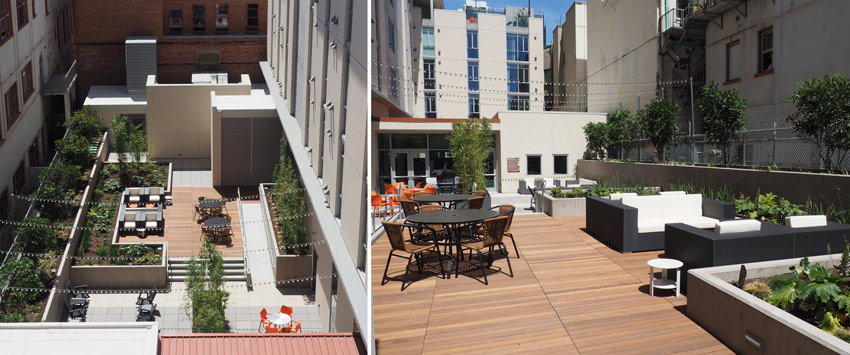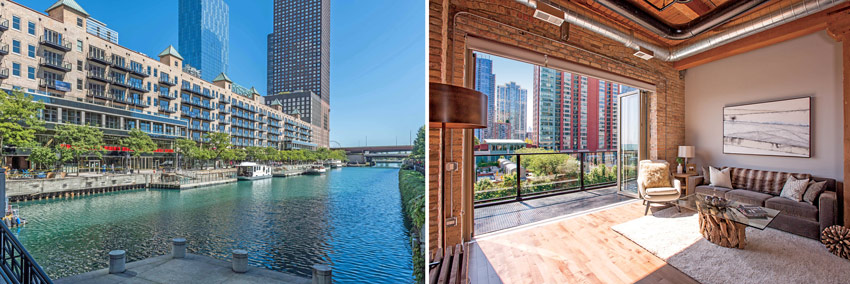Multifamily Housing Design Amenities
Innovation in creating and connecting with outdoor spaces in new and renovated buildings helps drive market appeal
![]() Continuing Education
Continuing Education
Use the following learning objectives to focus your study while reading this month’s Continuing Education article.
Learning Objectives - After reading this article, you will be able to:
- Identify and recognize the design significance of outdoor spaces as an amenity in multifamily housing projects.
- Assess the health and welfare aspects of providing connections between indoor and outdoor spaces.
- Explain the performance characteristics of adjustable pedestal roof deck systems and opening glass walls as part of the overall operation of multifamily housing.
- Determine ways to incorporate the principles presented into buildings as shown in case studies of projects.
Multifamily housing is currently reported to be a $66-billion segment of the annual construction activity in the United States. With this much activity, there are a number of trends that have been observed by numerous sources. First is the preponderance of urban projects. As Millennials and others continue the population shift away from suburbia and into more urban environments, the demand appears to be strong for more urban housing options. This demand is being met in both new construction projects and renovations of existing buildings that are being reclaimed and adapted for reuse as multifamily housing. The second notable trend is that the people who are renting or buying (i.e., condo/co-op) these units are interested in more sophisticated but affordable luxury, not only in the individual dwelling spaces but also in the building complex as a whole. That translates in design and construction into programming for common spaces, social gathering areas, outdoor places, and rooms for some specific activities like exercise, bike storage, pet care, etc. For real estate professionals and others, they describe these and other features as amenities that distinguish one property over another and provide the owner/developer with a competitive edge. Hence, it is becoming incumbent upon architects and other design professionals to acknowledge this need for marketable amenities and incorporate them into the design and construction of both new and renovated multifamily projects. Based on these trends, this course will take a closer look at two specific amenities that impact multifamily design, namely creating outdoor spaces and connecting those spaces with the indoors in innovative ways.
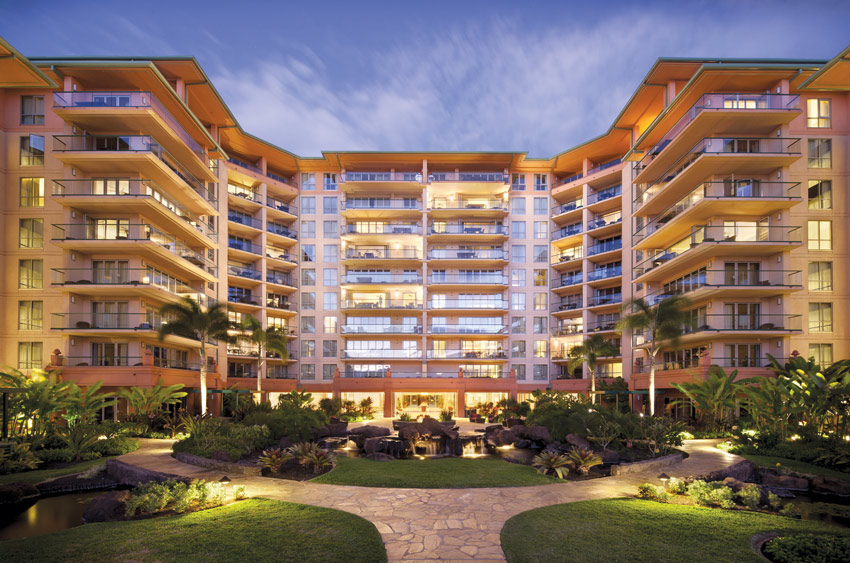
Photo courtesy of NanaWall Systems
The design of multifamily housing buildings are increasingly focusing on providing amenities for the occupants of those buildings, particularly ways to create outdoor spaces and connect them to the indoors.
Outdoor Spaces as Amenities
Multifamily dwellers value outdoor space, and developers want to provide it to them. However, there is always the need to be conscious of the cost of providing such a feature in a project, particularly if it is an urban site where land is expensive. Furthermore, outdoor spaces at grade may or may not be desirable if they border busy roadways or do not offer an inviting feel. Some exceptions to that seem to be for a “pop-up park” that takes over a sidewalk or street area to accommodate a group gathering or activity. Nonetheless, a more common approach to solving the need for outdoor space is to look to the building’s rooftop.
Roof terraces, decks, and gardens have been constructed for centuries on buildings of all types. In modern times, they have become appealing on multifamily homes as an alternative or supplement to balconies extending off of individual dwelling units. The primary design issue, of course, is how to take advantage of the roof space and still protect and preserve the roof membrane system. After all, the primary purpose of a roof is to maintain a waterproof barrier to weather, meaning that anything covering the roof to create an outdoor space needs to maintain that objective. Hence, a roof terrace or deck will need to avoid penetrations that could void a roofing warranty or otherwise create damage to the roof. The second design issue is that even low-slope roofs are still sloped, while people want to gather on a space that is level. Therefore, a means to create a level surface is needed.
Adjustable Pedestal Roof Deck Systems
The building industry has responded to these issues and concerns with complete systems for creating rooftop environments that are functional, environmentally appealing, and can be quite affordable for many budgets. The most widely adopted approach is based on the use of adjustable-height pedestals that sit on top of the roof membrane. The bottom of the pedestals can rest directly on the roofing membrane so no penetration is needed. They are held in place by the weight of pavers or wood tiles that are securely fastened to the top of the pedestals to create a new deck surface. Rainwater passes through the joints in the deck tiles and drains down onto the roof as always intended. In fact, the deck tiles can actually help preserve and protect the roofing since it becomes the primary weathering surface instead of the roof membrane. The top surface of the deck can be made level by independently adjusting each of the pedestals as needed to offset the roof slope or other irregularities at the point of each pedestal. The adjustability of the pedestals allows the system to be leveled to create a continuous, safe walking surface. As such, a coordinated system provides an interconnected assembly and an appealing, level roof deck.
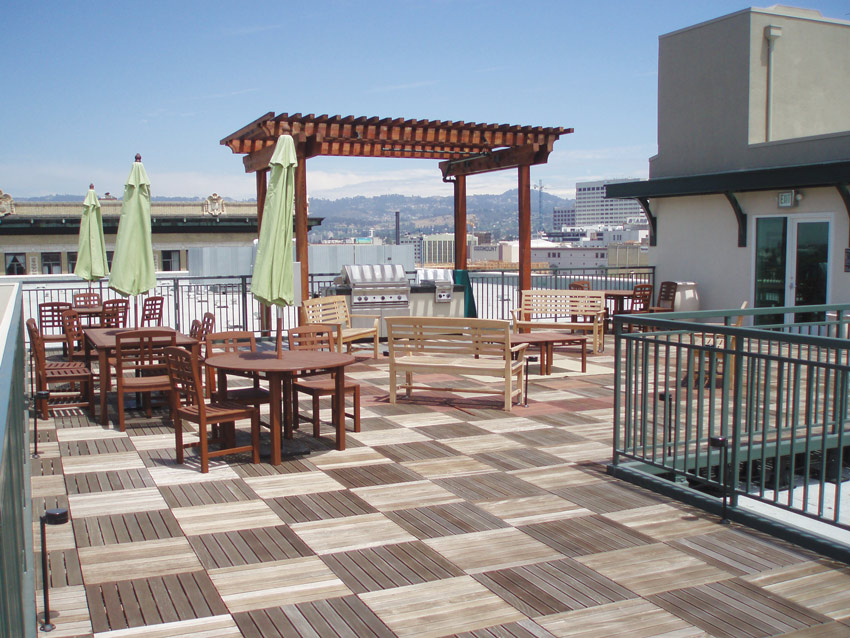
Photo courtesy of Bison Innovative Products
Outdoor spaces in multifamily housing are seen as valuable amenities that can differentiate one property from another for a competitive advantage.
Rooftop decks constructed in this way create a valuable amenity in the form of recreational or leisure space for building owners and their tenants and residents. Accommodating apartments, condominiums, and mixed-use buildings, adjustable pedestal rooftop deck systems offer the design flexibility to create versatile, unique outdoor spaces over any structural surface. Mark Fusco, LEED AP, GRP, national sales manager for Bison Innovative Products, has witnessed this firsthand. He points out that architects have been incorporating more roof decks into their projects because of the availability of these systems. “Architects can now design and specify tested, innovative systems for raised decks, including rooftop decks, plazas, terraces, pop-up parks, and other architectural features. Further, they can do so using maintenance-free adjustable pedestals and low-maintenance deck surfaces.”
Connecting Outdoor and Indoor Spaces
Outdoor spaces are clearly an amenity, but in order to fully enjoy and appreciate them, there should be a way to connect with them from inside spaces as well. This could be done in multifamily common areas that open onto outdoor spaces so that gatherings can flow over between indoors and outdoors. It could also apply to support functions (kitchens, restrooms, etc.) that can access those outdoor areas. The same is true in individual dwelling units too. Having a balcony or terrace as part of an apartment is great, but how is it accessed, and how does it connect to the inside of the unit?
This whole concept of blending and connecting indoor and outdoor spaces has been part of building design thinking for a long time and applied in many different architectural styles and eras. The premise is simple: People like being connected to the outdoor environment for the visual, daylight, fresh air, and other general well-being benefits that such a connection brings. Of course, variable weather conditions mean that sometimes people also need protection from the outdoors. So we routinely design walls with glass windows to allow views to the outside and provide some protection from the weather. If those windows are operable or if operable doors are used, they also allow a free exchange of outdoor air and breezes. When the weather is suitable, those opening glass windows and doors provide a healthier interior space that adds to our sense of well-being. If a door is used, it gives us direct, physical access to the outdoor space. When we want a barrier to prevent the flow of heat or cold air, the glass windows or doors need to be closed tightly enough to prevent air infiltration (drafts) and substantial enough to minimize heat transfer. It is ultimately a matter of design and the types of operable products used that will address these variable conditions in the context of any habitable building space, particularly in multifamily housing.
Opening Glass Walls
Recognizing a need to go beyond the capabilities of conventional windows and doors, products are available that use large, door-sized glass panels that can be readily opened or closed on demand. Referred to as opening glass walls, they allow an entire wall to open or close at will to provide a direct connection between indoors and outdoors. Like any other type of building fenestration, opening glass walls do not carry any structural load from the building but are reliant on being appropriately attached to the building and operating within a structurally supported opening.
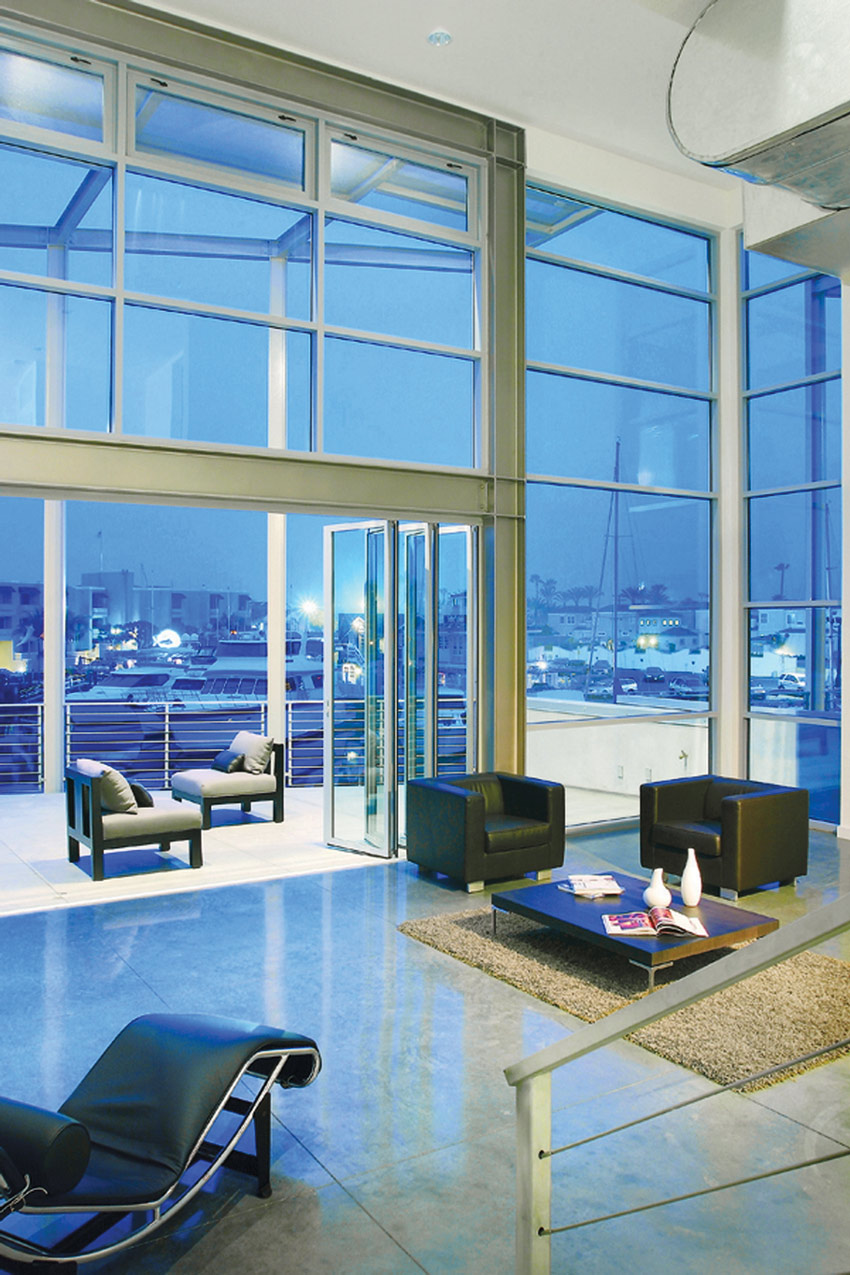
Photo courtesy of NanaWall Systems
Opening glass walls connect indoor and outdoor spaces by allowing full-size glass panels to move away when desired or close up tight when needed.
This type of flexible fenestration has been popularly used in a wide range of building types with a particular appeal for multifamily housing and mixed-use buildings. Specifically, opening glass walls can be used in dwelling units to seamlessly connect balconies or patios directly to indoor living, dining, or kitchen spaces. In communal spaces, they can provide comfortable and attractive four-season use of those areas by enclosing a covered patio or simply opening up a wall to enlarge the capacity of those spaces. With the glass walls open, such common gathering and dining areas blend smoothly between indoors and outdoors. When they are closed, the glass wall continues to provide views and daylight with a secure, transparent separation.
When opening glass walls are used as part of the building envelope, the performance of these systems is clearly critical. As such, it is important to compare manufacturers and specify products that can show documented capabilities to appropriately withstand the challenges of wind, water, extreme temperatures, impact, and overall durability. Looking at the testing data from the National Fenestration Rating Council (NFRC) is a good means to assess many of these characteristics. In multifamily housing units in particular, this comparison should also include attention to details such as tamper-resistant locking to ward off forced entry and acoustics to address noise abatement. It is also prudent to look for built-in adjustment and compensation points to ensure continued ease of operation if any building settling occurs over time.
Looking at this combined need for both design flexibility and high performance, Matt Thomas, marketing manager for NanaWall Systems, offers his perspective: “For us as a manufacturer, it is important to supply a product that enables the architects to fulfill their vision but also to provide a product that lasts. These performance points are as important to the architect as the aesthetic since we provide the product they are specifying on behalf of their client.” Clearly, there is a vested interest on the part of the manufacturers of these systems to meet both the design and performance needs of a project so that architects, owners, and inhabitants are all comfortable with them.
Designing Outdoor Roof Decks
Once the design decision is made to include an outdoor roof or terrace space in a multifamily project, the details of how to construct it then become important. Offering tremendous design flexibility and ease of installation, adjustable pedestal deck systems provide a unique and viable alternative to traditional deck building materials and methods. To help understand why, the following paragraphs provide a description of the main component parts of an adjustable pedestal roof deck system, commentary on how they fit together, and methods of integration into a new or renovated multifamily building.
Deck Supports/Pedestals
Adjustable pedestals are the structural supports for the deck surface, so they are the starting point for all systems. The use of adjustable pedestals as a support system has become recognized as one of the most labor- and cost-efficient methods of creating a level deck over a sloped surface. Pedestals are available in a range of heights and weight-bearing capacities to suit a variety of applications such as residential, commercial, and industrial design categories. Deciding which system to specify for a particular project is dependent on the support and elevation requirements of the design. Those carrying more weight or requiring more height to achieve a level condition will need a higher grade of pedestal.
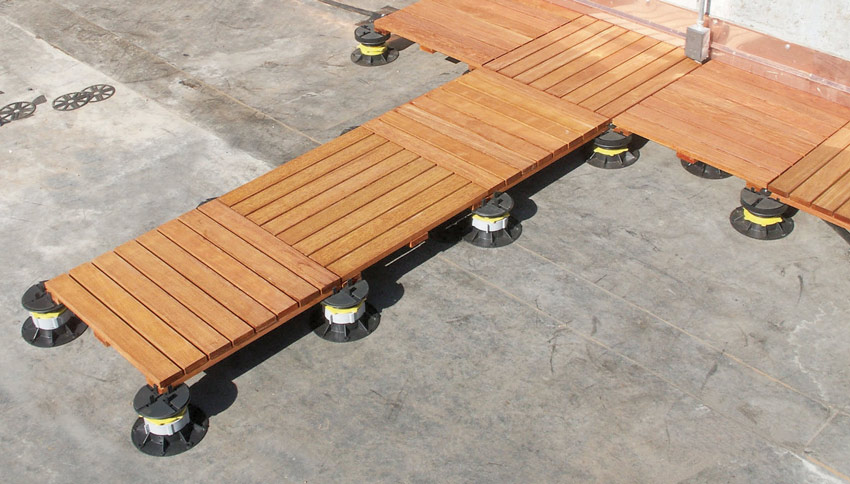
Photo courtesy of Bison Innovative Products
Adjustable-height pedestals can sit on top of a roof membrane safely, while a deck surface can be provided above to create an appealing, level outdoor roof space.
Many commercially manufactured pedestals are made with high-density polypropylene plastic that is 100 percent recyclable. This material choice means that the pedestals are essentially impervious to common outdoor concerns such as water, mold, and freeze-thaw cycles. As part of a gravity-based system, (i.e., no roofing penetrations required) the pedestal supports protect the roof and waterproofing membranes below without causing damage or harm to them. Pedestal deck systems can also be utilized over any other structural surface, including on bare structural decks, rooftop decks, existing plazas/terraces, compacted grade, pavement, pool surrounds, inside of water features, or between green roof areas.
The cavity space created by the pedestals can be used strategically to allow for electrical wiring, recessed lighting, duct work, and even irrigation. The location of the pedestals is typically based on a modular layout that follows the size of the material used on the deck surface. Commonly, this is a 2-foot-by-2-foot square module, although many other sizes are possible as well. The modularity and particular design of the deck surface will be used to locate the specific location of the pedestals.
Deck Surface
The versatility of adjustable pedestal deck supports means that they can be used to elevate a variety of decking surface materials. The common options include pavers made from concrete or stone, such as granite or travertine. Lighter-weight choices include fabricated 2-foot-by-2-foot tiles made from hardwoods or composite materials. Wood products can be specified to be certified by the Forest Stewardship Council (FSC) or similar organizations for sustainability. Similarly, structural porcelain tiles or grating can be used in a grid pattern to meet different design requirements. There is even the option of inserting a shallow tray on top of the supports to contain loose crushed rocks, planter cubes for vegetation, or modular bench seating. With all of these options, and because of the modularity of the system, any single roof deck does not need to be limited to a single choice. Rather, many architects have created elegant deck designs by mixing and matching different materials within the grid system to meet different needs, provide visual interest, and generally enhance the overall design of the outdoor space.
Weighing one-third as much as concrete tiles, wood tiles are often considered to be a good alternative when surface-material weight is a factor. Typically made from hardwoods in a variety of species, wood tiles are commercial grade and available in standard and FSC-certified options. Not only do these wood tiles contain a rich variety of graining and coloration, but they are also exceptionally dense and resistant to insects. As such, they weather well and require minimal maintenance. If maintaining the wood color is desired, wood tiles can be periodically cleaned and sealed. Left to weather naturally, the wood tiles will develop a silvery-gray patina. Either way, wood tiles are ideal for blending the warm beauty and upscale appearance of real wood with durability and low maintenance.
For a total design look, wood tiles can be laid in a parquet or linear pattern, or mixed with pavers, river rock, stone, plank decking, or other materials to create unique aesthetics. Any or all of these deck surface options can be removed from the top of the pedestals for routine maintenance, repairs to the roof, or access to other systems.
Other Deck Design Considerations
There are a number of other ways that adjustable pedestal roof deck systems can be integrated into roofing designs. For example, green roofs are increasingly popular as a way to expand usable roof space to include gardens and control drainage. Designs that include green roofs typically demonstrate an imaginative use of materials that minimizes maintenance and the environmental footprint of the building. By incorporating a pedestal system into a green roof, a pedestrian walkway can be provided for easy maintenance access.
Other roof deck design options that are ideal for an adjustable pedestal deck system can include water features. The elevated system conceals the water supply beneath the deck surface materials and allows water to drain to the roof surface below for recycling or reusing. Since the supports are impervious to water, mold, and most chemicals, they can function well for many years of service. Similarly, recessed lighting can be incorporated into the system by running the wiring beneath the deck surface. This can enhance the ambiance of the outdoor space and improve visibility and safety during nighttime and/or dark conditions.
Of course, the deck does not need to cover the entire roof in any of these scenarios. It can be sized to suit the needs of the project such that it avoids other rooftop equipment or features, provides a geometry that is visually interesting, or is just sized to accommodate the programmatic needs of the space. Similarly, smaller sections can be located on different parts of a roof or on different levels of a building, depending on the building design.
Site Furnishings
With the pedestals and the deck surface in place, it makes sense that manufacturers offer a series of deck furnishings to fit with the modularity of the deck system. For example, modular wood cubes are available with an array of design options to incorporate seating, storage, and planters. These cubes are dimensioned to integrate precisely with the wood deck tile modularity, making it easy to design a fully coordinated outdoor environment. Such cubes are available with a polyurethane lining and drainage holes to host plant life. At other times of the year, the cubes can be repurposed for seating and storage of seasonal items (i.e., cushions and pillows) by placing a manufactured hardwood top on the cube. Custom sizes and species are available as well.
If a different look is desired, aluminum cubes are also an option. Designed to withstand temperature extremes, these low-maintenance, durable planters are constructed of lightweight, partially recycled aluminum. Some use an industrial strength powder-coated finishing process that is applied electrostatically and cured under heat, creating a more resilient finish than conventional paint. The process does not emit any volatile organic compounds (VOCs) into the air and allows the cubes to be coated with virtually any paint color. Aluminum cubes typically contain recycled content, are 100 percent recyclable, include drain holes, and have irrigation sleeves. There are a variety of size and color choices available.
A rather unique item that can be added into the decking modules are lightweight aluminum cube trays. These trays are used as a containment system for architectural rocks or other deck materials to create a visual and textural design feature. The aluminum trays are corrosion resistant and available in a variety of standard and custom size options related to the modular sizes of the rest of the system.
Overall, pedestal systems create valuable, usable outdoor space for both owners and their residents, tenants, and visitors. Rooftop decks are clearly a way for multifamily dwellings or common spaces to differentiate themselves from the competition.
Designing Indoor/Outdoor Connections with Opening Glass Walls
Architects have begun to recognize that opening glass walls provide a solution for increasing usable space with the ability to maintain or enhance energy performance. Owners like the fact that they can enhance the value of dwelling units or help differentiate their building from other multifamily properties to create a unique market offering. In locations where the geography provides desirable views, everybody likes the fact that opening glass walls can provide unobstructed sight planes to take full advantage of those vistas. In most settings, the overall intent is to allow a large, uninterrupted opening between an indoor and outdoor space (or sometimes between two interior spaces), thus making smaller spaces feel larger or simply allowing people to feel connected to the outdoors. Whatever the reasoning, once the decision is made to incorporate an opening glass wall system into a project, the details and choices to then consider can include the following.
Opening Glass Wall Design Characteristics
All opening glass walls are made up of individual panels that include the glass and a frame around it. The makeup of the individual panels can be specified to suit a project based on a number of standard options. The frames can be either solid wood or aluminum, or a combination in the form of aluminum clad wood. When aluminum is selected, the frame can include thermal breaks for exterior installations or be continuous extrusions for interior applications where thermal transfer is not a concern. The glass in the panels can similarly be selected to suit interior or exterior conditions with single, double, or triple glazing. There are also all of the usual choices for treating that glass for enhanced energy performance (low-e coatings, inert gas filled, other coatings, etc.). Structurally glazed, frameless systems are also available from at least one manufacturer for systems where it is needed or desirable.
There are essentially three different ways that the panels can be configured into a full opening glass wall system. The first, and most common by far, is a folding glass wall system, which represents on the order of 80 percent of all of the systems installed in the United States. Some of the reasons for this include the fact that folding glass walls are easier to operate and have better air and water performance than other systems. From a structural standpoint, the dead load of a folding system is kept within the plane of the opening, with the panels capable of being either top supported or floor mounted.
In essence, a folding glass wall system consists of a number of hinged panels that fold together and slide out of the way. These panels may be hinged together in pairs or a large number of connected panels like a train. Many opening configurations are possible with inward, outward, or center-pivot opening options. Folding panels can enclose a variety of shapes such as straight walls, open corners, and even segmented curves. It is also possible to use folding glass wall systems with a corner-less configuration using paired panels.

Photos courtesy of NanaWall Systems
Opening glass wall systems are available in a variety types, including folding glass walls and thin-profile sliding glass panel systems.
The second type of opening glass wall system uses individual top-hung panels that slide on a single overhead track and are guided on a single floor track. These sliding panels then stack in one or more parking bays outside the plane of the opening. The end-to-end closure of a single-track sliding system creates a streamlined look and a tight weather seal. Sliding-panel opening glass walls can be sized for small or large openings, and the materials used can be selected from the standard variety of wood, aluminum, and glass types. Generally speaking, sliding glass walls offer more flexibility in design compared to folding panels for large openings. Their size is restricted only by the building structure, allowing for virtually unlimited widths, as the panels can slide individually and be stored off to the side of one or both ends of the opening. Since they do not necessarily require a floor track, the floor is uninterrupted when the panels are open and people are walking through the opening. The panels may also have swing doors incorporated into them wherever desired so the entire wall does not need to be open for people to pass through.
The third type of opening glass wall is multi-track, minimal-frame sliding glass panel system. In this type, the profiles and frames are as slim as possible, allowing for maximum indoor/outdoor connection even when the glass panels are closed. The very thin frames provides maximum views and minimum visual distraction overall creating a very modern look for the opening. They are considered a best choice when complete connectivity between the inside and outside is being sought since they allow more freedom and transparency. In this case, the glass panels slide across the face of each other and out of the way for completely open spaces. The thin aluminum frames produce clean and uniform lines while allowing for larger overall panel sizes. It is also possible to include matching fixed panels to balance out the design of the layouts, open or closed.
Structural Openings
Folding glass wall systems are available in sizes up to 10 feet high and 43 feet wide. This is great in terms of design potential and flexibility, but it also means that a structural opening needs to be designed independently to receive the designated size of the glass wall system. In particular, the header or beam above the glass wall needs to be checked for deflection so that it does not interfere with the smooth operation of the door. Multifamily projects sometimes use structural elements that have more allowable deflection across an opening for other types of fenestration. For opening glass walls, the manufacturer should be consulted to determine what is required or acceptable in this case, particularly on openings with longer spans.
When considering the impact of the folding glass wall on the building structure, keep in mind that floor-supported systems generally allow for easier design since the weight of the system is on the floor and not the beam or header above. This approach tends to offer smoother operation as well. Nonetheless, both head and floor supported systems are available. As a hedge against long-term settling or building movement, some opening glass walls offer height and width adjustability to compensate for any changes over time.

Photos courtesy of NanaWall Systems
The performance of an opening glass wall system will be dependent on the choices made for the different types and components that are used to manufacture the system.
Opening Glass Wall Performance Characteristics
Window and door systems in a building enclosure are typically a performance weak spot in terms of energy and weatherability. This is particularly true in mid-rise and high-rise multifamily projects that can be subjected to greater wind and other forces compared to ground level. Fortunately, folding glass wall systems are available that have been independently tested and shown to be capable of meeting the demands of these situations. In particular, unit U-factors can be specified as low as 0.2 with triple glazing. Similarly, air infiltration has been measured as low as 0.125 at 1.57 psf (75 Pa). Both of these conditions contribute to the availability of ENERGY STAR rated products.
When it comes to the structural integrity of opening glass walls in high-wind conditions, they have been tested to perform well up to 35 psf for folding glass walls and up to 60 psf for sliding systems. In terms of maintaining security in the building, all have been shown to provide excellent forced-entry resistance when tested per AAMA 1202.5 and CAWM 300-96. And since sound is often a concern in multifamily housing, the systems have been tested and can achieve sound attenuation ratings up to STC 45.
When looking at these different performance characteristics, keep in mind that inward opening folding glass wall systems offer better performance and safety capabilities than outward opening systems since the wind dynamics are a bit different. They are also easier to clean since both sides of the glass panels are accessible from the inside. The sills of the folding glass wall systems will make an impact on performance as well. Folding glass wall systems with ADA (low-profile) sills need to be assessed in terms of water resistance compared to some others. Still other sills with higher profiles have been found to support higher water-resistance ratings during field testing.
Overall, it is easy to see why opening glass walls have been used in a variety of luxury and other multifamily projects throughout North America.
Conclusion
Residents of multifamily housing are looking for amenities that suit their lifestyles and meet their demand for access to outdoor spaces. Building owners are happy to meet that need as long as it can be integrated appropriately into the building construction and budget. Architects and other design professionals can use the approaches presented in this course to meet those needs in a creative, elegant, and affordable manner.
Peter J. Arsenault, FAIA, NCARB, LEED-AP is a nationally known architect, consultant, con-tinuing education presenter, and prolific author of more than 200 continuing education courses. www.pjaarch.com, www.linkedin.com/in/pjaarch



